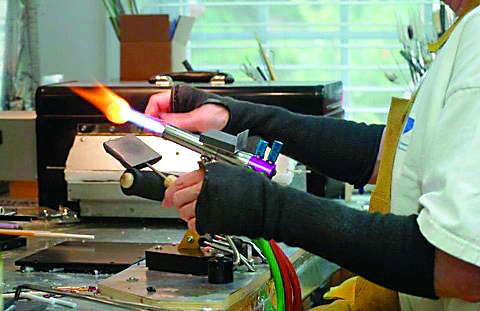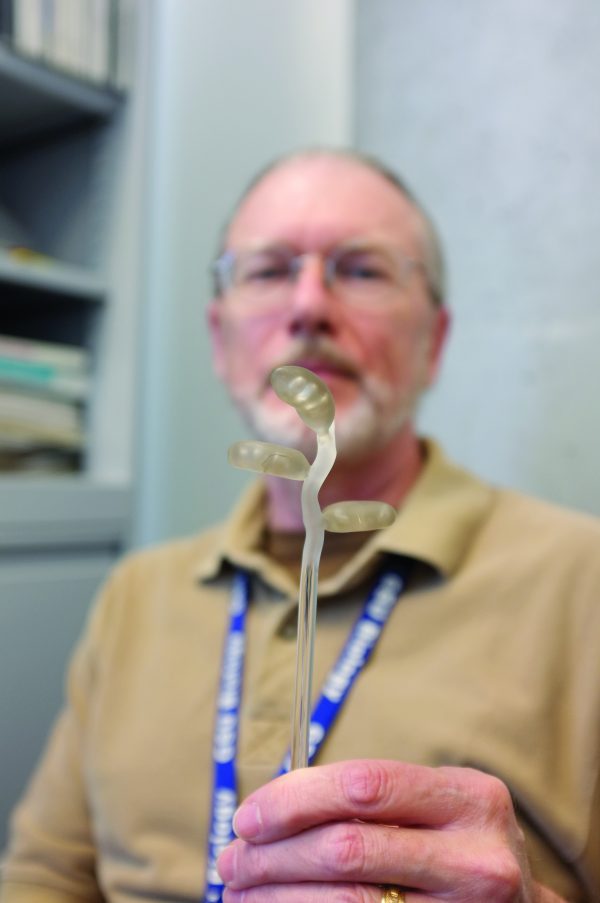
Robert Simmons of Georgia State’s Biology Department is not your average biology professor.
What do you get when you cross a woodworker, a musician, a glassblower and a biologist with a photography hobby?
It sounds like the beginning of a terrible joke, but the reality is much more interesting.

Biology professor Dr. Robert Simmons, who is inspired by life underneath a microscope, holds a glass model of the fungi curvularia geniculata that he created.
“I’m a creative guy,” Robert Simmons said with a laugh after reciting his seemingly never-ending list of hobbies.
Simmons managed to work these hobbies and interests into his average day, leaving us all to wonder how on earth he does it. After all, he has the same 24 hours and 7 days a week as the rest of us, doesn’t he?
Perhaps the most prevalent of his interests is glassblowing. Since the age of 10, Simmons has been fascinated with the process and has since learned the art and turned it into a regular hobby.
“I never really got to do much with it until about 10 years ago,” said Simmons, who built a studio behind his house and learned to make glass art beads so that his wife could pursue her hobby of jewelry making. “So we put our heads together and I started making beads.”
The beads have gone a long way since then. Now they are used as milestone markings for children with serious illnesses, like cancer. Beads of Courage is an organization that helps children cope with life threatening illnesses through art.
“They get different color beads to symbolize their treatment journey,” said Jean Baruch, the executive director and founder of Beads of Courage. For example, overnight hospital stays will earn a child a yellow bead, skipping school for a treatment will earn a blue bead and so on.
“Beads have been used by humans as a form of recognizing honor and accomplishment for over 100,000 years,” continued Baruch. “It’s a very visual translation of their treatment journey. The beads become long lasting symbols of that child’s courage.”
Of all his hobbies and work, Simmons counts his position as the director of bead donations for Beads of Courage among the most rewarding and one of the best things he has done in his life.
While he relishes seeing his students move on to successful careers, he says that his work with Beads of Courage has been a different sort of meaningful experience.
“There is a relationship established that is hard to describe,” Simmons said. “Shared experiences in very difficult times forge a bond that is very meaningful and I treasure these.”
Simmons always seems to find a way to link his artistic side with his scientific side.
“Many things in this life reconnect in ways you might not immediately expect,” he said. From glass sculptures of micro-fungi to a photo series of microscopic things found on beaches, he’s found a way to weave biology into his hobbies.
“A lot of people think science and arts are opposites when actually they’re two sides of the same coin,” Simmons said.
“To be successful as a scientist you have to be able to make creative, new ideas with data. It takes a creative leap at many times. If you’re going to be an artist you have to have some sort of innate understanding of the technology you’re working with in your art.”
Needless to say, Simmons has made sure to embrace all sorts of chances to live life to its fullest.
“You can get your feet wet without having to make a capital investment,” said Simmons to those who want to take up a new hobby. “There are a lot of opportunities to take.”
And it’s not long before Simmons begins his next project: being a part of a National Geographic film education series.
“I might get to share my enthusiasm for science and technology further down the road, if all goes well.”
